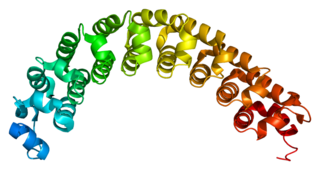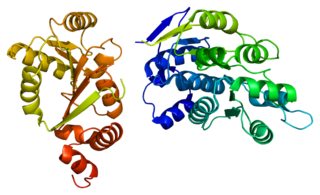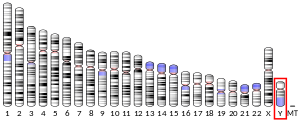
Y linkage, also known as holandric inheritance, describes traits that are produced by genes located on the Y chromosome. It is a form of sex linkage.

Azoospermia is the medical condition of a man whose semen contains no sperm. It is associated with male infertility, but many forms are amenable to medical treatment. In humans, azoospermia affects about 1% of the male population and may be seen in up to 20% of male infertility situations in Canada.
Azoospermia factor (AZF) is one of several proteins or their genes, which are coded from the AZF region on the human male Y chromosome. Deletions in this region are associated with inability to produce sperm. Subregions within the AZF region are AZFa, AZFb and AZFc. AZF microdeletions are one of the major causes of male infertility for azoospermia and severe oligozoospermia males. AZF is the term used by the HUGO Gene Nomenclature Committee.

Deleted in azoospermia-like is a protein that in humans is encoded by the DAZL gene.

Deleted in azoospermia 1, also known as DAZ1, is a protein which in humans is encoded by the DAZ1 gene.

Ubiquitin specific peptidase 9, Y-linked , also known as USP9Y, is an enzyme which in humans is encoded by the USP9Y gene. It is required for sperm production. This enzyme is a member of the peptidase C19 family and is similar to ubiquitin-specific proteases, which cleave the ubiquitin moiety from ubiquitin-fused precursors and ubiquitinylated proteins.

Deleted in azoospermia protein 2 is a protein that in humans is encoded by the DAZ2 gene.

DAZ-associated protein 1 is a protein that in humans is encoded by the DAZAP1 gene.

Pumilio homolog 2 is an RNA-binding protein that in humans is encoded by the PUM2 gene.

Quaking homolog, KH domain RNA binding (mouse), also known as QKI, is a protein which in humans is encoded by the QKI gene.

RNA-binding motif protein, Y chromosome, family 1 member A1/C is a protein that in humans is encoded by the RBMY1A1 gene.

ATP-dependent RNA helicase DDX3Y is an enzyme that in humans is encoded by the DDX3Y gene.

Testis-specific chromodomain protein Y 1 is a protein that in humans is encoded by the CDY1 gene.

Protein boule-like is a protein that in humans is encoded by the BOLL gene.

DAZ-associated protein 2 is a protein that in humans is encoded by the DAZAP2 gene.

Zinc finger protein DZIP1 is a protein that in humans is encoded by the DZIP1 gene.

Variable charge X-linked protein 1 is a protein that in humans is encoded by the VCX gene.

Testis-specific basic protein Y 2 also known as basic charge, Y-linked 2 is a protein that in humans is encoded by the BPY2 gene which resides on the Y chromosome.

Mild androgen insensitivity syndrome (MAIS) is a condition that results in a mild impairment of the cell's ability to respond to androgens. The degree of impairment is sufficient to impair spermatogenesis and / or the development of secondary sexual characteristics at puberty in males, but does not affect genital differentiation or development. Female genital and sexual development is not significantly affected by the insensitivity to androgens; as such, MAIS is only diagnosed in males. The clinical phenotype associated with MAIS is a normal male habitus with mild spermatogenic defect and / or reduced secondary terminal hair.
The DAZprotein family is a group of three highly conserved RNA-binding proteins that are important in gametogenesis and meiosis. Therefore, mutations in the genes that encode for the DAZ proteins can have detrimental consequences for fertility.
















